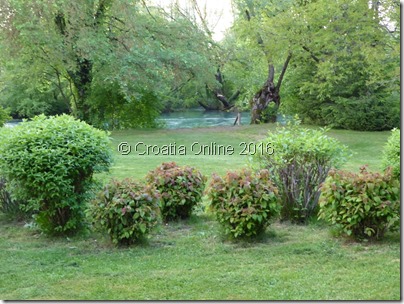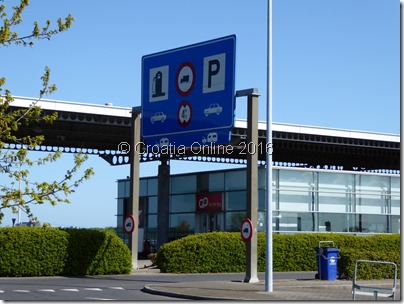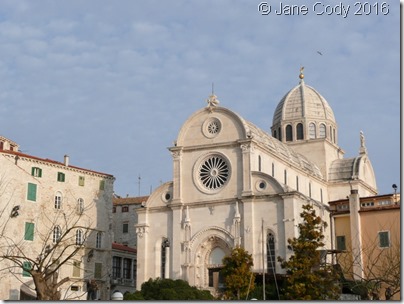
It’s very difficult to leave a campsite like Putterersee in a hurry – see Croatia Camping Guide - Driving To Croatia Day 3 - Austria for more information. In fact, as my trip continued, I frequently had to overcome a reluctance to leave some very special places. I learnt eventually, with growing confidence, that there would be plenty more special places to come. It was not so much wanting to get my money’s worth out of our normally short stays at campsites, but the fact that I wanted to do each place justice There’s nothing worse than being somewhere for a short space of time, probably never to return, and missing the specific thing that makes the place super special. The nearest I got to that was on the way back when we stopped just off the motorway at a not especially appealing campsite by a canal. It was raining, we were tired, there was a big football match on and we had eaten and drunk well in the campsite restaurant while we watched it. If it wasn’t for the fact that the dog had had a pretty boring day cooped up in the campervan, as we covered more than our usual number of miles, I probably would not have made the effort to walk along the canal where he could run around a bit. Ten minutes later we were in the chocolate box German city of Limburg marvelling at the amazing architecture.
So, apart from the myriad of daily “campervan” jobs that need doing, as well as meal times and walking the dog, I felt we had a duty to explore our neighbourhood and make the most of it. And of course travelling with a (sometimes wet) dog in close confines means a daily spring clean can make a big difference to your air qualityand that takes time too! In the end, despite our best intentions, we rarely managed to leave a campsite within less than three hours of getting up and I learnt, eventually, not to worry too much about this. Even if we only did fifty or so miles in a day we had somewhere new to explore. And on the rare occasion we treated ourselves to a second day in the same place, it took a major effort to completely relax for a day, once we had run out of jobs to do.
In these early days of the trip, we were up with the lark and so left our idyllic Austrian campsite at 11 30 after a reasonably leisurely morning. Ten minutes later we topped up with diesel in Leizen – BP Ultimate @ €1.179 a litre though usually we just get normal diesel (and this just proves that the garage on Day 3 was a rip off) – and were off.
It was not long until we were at the Slovenian border, already prepared with our vignette, purchased in Austria from “Frau Grumpy” the previous day. Having kept my expectations very low, I was not too disappointed with the Slovenian roads. I have been making periodic trips to Croatia via Slovenia for well over ten years and throughout this time the Slovenian part of the journey has always been the most painful – expensive vignettes, poor roads and motorways interminably under construction. OK so the motorway part is a little longer than it was four years ago but the potholes on the narrow single carriageway roads by the roadworks are dreadful and we shook to our bones for several slow miles following lorries and tractors. The bottleneck at Maribor has now been largely overcome by the motorway but, overall it’s a disgrace, especially considering the cost of the vignette, and I swear the Slovenians must be building the motorway at the same pace as we poor travellers are funding it with our exorbitant vignette fees. I thought very hard about avoiding Slovenian motorways altogether, on principle, by going via Trieste but it’s not so quick and so I gave in.
And just to add insult to injury, as you leave Slovenia and enter into Croatia, the Slovenian guards seem to make a point of leaning over a car and turning their backs to you, as if they don’t want anything at all to do with you.
So it was with even more joy that I finally reached the Croatian border and got on a Croatian motorway heading for Zagreb, where the lovely Croatian toll booth attendant got out of his booth and went to get the ticket for me to avoid me reaching over to my passenger side and struggling with the ticket machine. The newish motorway was almost deserted and very smooth, so we sped across Croatia until we were attracted by a very effective piece of marketing for Camp Slapić which was advertised periodically on big signs. “Why not have an early stop” I thought, now we have made Croatia, and so we followed the signs and ended up spending the night near Karlovac in one of Croatia’s newest and highly prized campsites. We could have made the coast in another couple of hours but what’s the point of arriving exhausted when you can make an early stop by some lakes. It was quite a detour from the motorway though and I’m not convinced the distances suggested on the billboards were entirely accurate!
***
We covered 228 miles on day four, a total of 1,141 miles since we left home in Suffolk and, would you believe, exactly 1,000 miles from Eurotunnel! A relatively easy four days of driving, three brilliant campsites, one excellent wild camp, scenic views and really only the Slovenian roads to moan about. Yes there were a few contraflows, or stretches of roadworks, on the German motorways and just a couple of small jams. However on a road network that vast, and a motorway that runs by so many big cities, that’s only to be expected. And lets not forget that, so far, the German motorways are toll free.
I chose my route because I thought it was the fastest and simplest to navigate. Last time I did the trip in my campervan, when I had a lot more time for the journey, I meandered off and on the motorways on the way over and took a completely different route on the way back, stopping off at Lake Garda in Italy, taking the St Bernard’s Pass into Switzerland and ambling through Champagne in France where I found one of my favourite campsites ever but that’s another story!
Just a few closing tips on the drive:
- If you’re camping and you are new to it, you’ve got to try and get out of the mindset of wanting to travel from a to b as fast as possible. The journey really is part of the fun if you let it be. The same can apply if you’re travelling by car but there’s just a bit more pressure to find the right kind of hotel room for your budget. If you take the same route as me though, you can be pretty sure of a mid range budget room at many of the motorway stops.
- If you’re travelling with a dog and you’re going to be travelling for a few days then the last thing you want is for the poor dog to hate going back into your vehicle because you are not stopping enough and having fun along the way. If you’re in a campervan and your dog sleeps on the floor, bear in mind that, however good his bed is, his poor head will be bumping up and down with every little imperfection in the road. In the end, on days where we drove a lot of miles, I put extra cushions down for my dog and I think it really made a difference for him to have his head just a bit higher and more “shock absorbed”. In a car, the shock absorbers tend to have an easier time and dogs often travel on the seats. I never drove for more than two hours at a time without a break and I tried to make sure we were never on the road for more than 5 hours a day or, if we were, there were some long breaks – at least an hour- in between. The dog was fine – he has a sturdy well padded waterproof bed wedged between two of the seats, is allowed on top of one of the seats and can walk around (but not the cab area) at will. He seemed to prefer, however, his head on a cushion, lying stretched out on the floor in the narrow aisle. A much because it was cooler on the floor, I think, than because it was more comfortable.
- Off season, unless there’s some big festival going on, or it’s a bank holiday, then you’ll rarely find a campsite that’s fully booked. So it’s fairly safe to turn up on spec and that gives you so much more flexibility. If you’re too off season, though, you might find them closed so check on opening times before you make the detour. Not one of the campsites I tried in May or June was closed but as I got towards the Croatian Coast, several of them were still undergoing maintenance work, sometimes substantial! Just one, in Sv Filip i Jakov, near Biograd, was full up (now June and very warm). It was a lovely “minicamp” – in someones’s (large) back garden but with all the essential facilities. No great problem though as her next door neighbour also had a minicamp and was delighted to absorb the overflow! If you’re in a car and relying on motels, we never had a problem finding a room in the old, pre campervan, days but we generally made sure we stopped before 6 and often by 4. If you’re camping, you can go on longer and I never had a problem arriving at 7 or sometimes 8. Of course you could book everything ahead but then you are stuck with a rigid itinerary. If one little thing goes wrong, or you don’t like somewhere and want to leave early, or you do like somewhere and want to stay longer, you are faced with teh domino effect of having to change all your bookings.
- To give yourself the best chance of minimising traffic jams, avoid the big cities and busy roads, like the Brussels ring road, at peak hours.
- Avoid the “big” weekends for people travelling down to the coast from Germany and Austria, normally in high summer. The Croatian website HAK is a good reference point for current and predicted future traffic problems in Croatia and many map Apps and Satnavs also indicate current traffic problems.
- Lorries are banned at weekends on some continental motorways, particularly in summer so if you are flexible in your travel arrangements and prefer quieter roads, try the weekend.
- Be aware that in some service stations, particularly those in more remote areas, lorries parking up overnight can fill up, not just their own parking areas, but also sometimes caravan and car parking areas too, as well as approach roads where it is relatively safe to do so. Afternoon and evening are obviously likely to be busier than in the morning so if you are looking for a rest stop on the busy motorways you may need to get there early.
- Most of the German motorways are two lane only, with occasional crawler lanes or three lane stretches near the bigger cities. Lane discipline is very important and the Germans, especially, will quickly let you know if you are hogging the overtaking lane. I did however notice this time, now speed limits have been in force on German motorways for a while, that not so many Germans drive quite so fast as they used to. Despite that, I was still one of the fastest on non German motorways, though one of the slowest on the Autobahns so you will need a different kind of driving approach as you cross borders!
- Have plenty of layers of clothing handy – the climate can change in an instant, for example from day to evening and after you’ve driven through a long tunnel through the mountains.
- Stop as soon as you feel you need to and keep your tank topped up – if you wait for the next service station you might find it’s another 70 kilometres away. You will be passing through plenty of rural areas where amenities may be a lot scarcer than they are in the UK.
- Keep plenty of change handy for paying tolls but note that the Croatian toll booths, particularly in the north, will accept Euros as well as kuna.
- Be aware of the weather – if you are travelling in, say, March, you may still need snow tyres in some places, or chains. The wind can be a factor too – a strong Bora (north east wind) may close the Croatian motorway north of Zadar and can be very uncomfortable in various places along the route.
- ENJOY!
Overall you just need to turn the journey into handleable chunks. Stop when you feel tired, perhaps drive a bit more when it’s raining and enjoy your overnight location more when the weather is good. Maybe think of the last long journey you made in the UK and compare that in distance. For example, a few days after I came home, I went to visit my niece in the Lake District for a few days. We did a little driving around locally and when I got home I’d done 720 miles. It seemed like no great distance but it could have taken me three quarters of the way to Croatia.
Over the next few days and weeks, you’ll be able to read more about our Croatian campsites on Croatia Camping Guide, more about the new marinas and other nautical facilities we discovered on Croatia Cruising Companion and we’ll be keeping you in touch with general Croatia news, discoveries and stories here, on Croatia Online.
***
Today’s photo is of the lake by Camp Slapić, with very fast flowing water from which I had to rescue my over adventurous dog!
![]()










